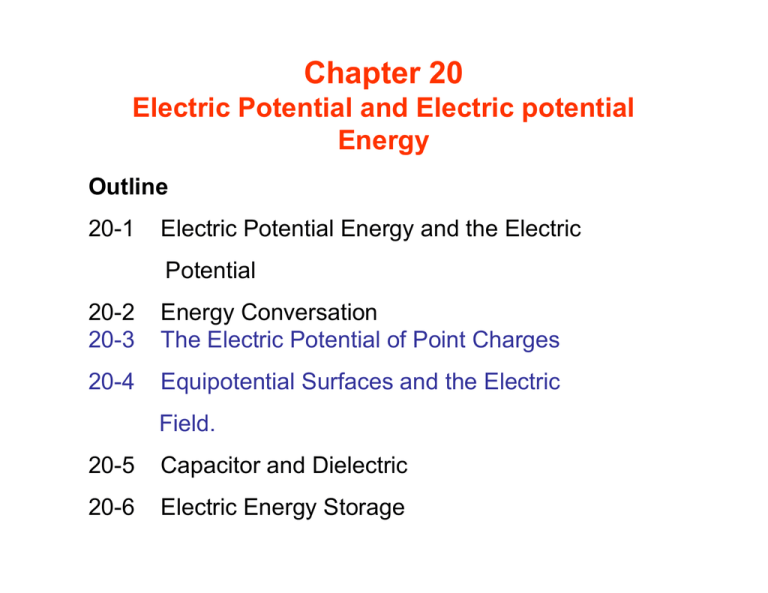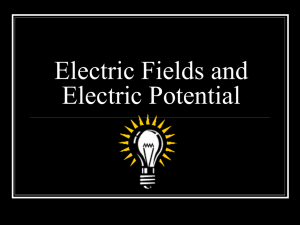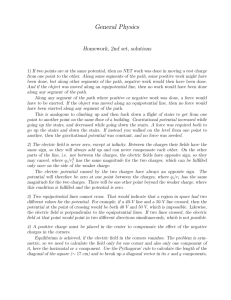Chapter 20 Electric Potential and Electric potential Energy
advertisement

Chapter 20 Electric Potential and Electric potential Energy Outline 20-1 Electric Potential Energy and the Electric Potential 20-2 20-3 Energy Conversation The Electric Potential of Point Charges 20-4 Equipotential Surfaces and the Electric Field. 20-5 Capacitor and Dielectric 20-6 Electric Energy Storage 20-3 The electric potential of point charge Deriving electric potential of point source Consider a point charge, +q, at the originate of the coordinate system shown in the figure. Suppose a positive test charge, +q0 is held rest at point A, a distance ra from the origin. Figure 20-4. Energy Conservation in an Electrical System After q0 moves to point B, it can be derived by integral, that the difference in electric potential energy between points A and B is U A −UB = kq0 q kq0 q − rA rB The corresponding change in electric potential is VA − VB = U A / q0 − U B / q0 = kq kq − rA rB If the test charge is moved to infinite, rB → ∞, we have kq VA − VB = rA We define the potential to be zero at infinite from the given charge, and we have VB = 0. Electric potential for a point charge SI unit: Volt, V kq V= r (20 − 7) Two Charges: Electric potential energy for point charge q and q0 with r separated distance kq0 q U = q0V = (20 − 8) r SI unit: Joule, J Note: The electric potential / energy is zero at infinite distance. Negative charge has a minus V. 20-23 The potential of a Point charge The hydrogen atom consists of one electron and one proton. The electron orbits the proton in a circular orbit of radius 0.529x10-10 m. (a) What is the electric potential due to the proton at the electron’s orbit? (b) What is the potential energy of the atom at the orbit? Figure 20-5 The Electric Potential of a Point Charge Positive charge at origin Negative charge at origin Superposition The total electric potential due to two or more charges is equal to the algebraic sum of the potentials due to each charges. The potential of positive and negative charges may be cancelled each other. Pay attention to the sign of the charge! Example 20-3 Two point charges A charge q=4.11x10-9 C is placed at the origin, and a second charge of -2q is located on the x axis at the location x=1.00m. (a) Find the electric potential midway between the two charges. (b) The electric potential vanish at some distance between the two charges. Find the this value of x. Picture the problem Example 20-3 Two Point Charges 20-33 Multiple Charges (a) Find the electric potential at point P in the following figure. (b) A fourth charge, with charge of +6.11 uC and a mass 4.71 g, is released from rest at point P. What is the speed of the fourth charge when it has moved to infinite distance? 20-4 Equipotential surfaces and the electric field Like the geometric contour map that is used to indicate the different altitudes, a equipotential plot/map, which consists of equipotential surface, could be used to indicate the difference of the potential. Figure 20-6 Equipotentials for a Point Charge An equipotential plot must contain the following information 1) Relative magnitude and direction of the electric field. • The E = - ΔV / ΔS, depend on the rate of the change of the potential. • The electric field points in the direction of decreasing electric potential. 2) The electric field is always perpendicular to the equipotential surface. Figure 20-7 Equipotential Surfaces for a Uniform Electrical Field The electric field is perpendicular to the equipotentials and points in the dirtcion of decreasing potential. Ideal Conductors Charges on ideal conductor can move freely and with no work being done. Figure 20-9 Electric Charges on the Surface of Ideal Conductors Why the charges have high density (large electric field) at the sharp end? Figure 20-10 Charge Concentration Near Points In figure (a), the potential at its surface is the same as for a point charge Q at the center of the sphere, kQ kσ (4π R 2 ) V = = = 4π kσ R R R Where σ is the charge density. Consider (b) with a sphere of R/2, for the same potential with (a), we have V = 4π kσ b ( R / 2) = 4π kσ R σ b = 2σ This prove that small radius surface has large charge density. Summary 20-5 The Electric Potential of Point Charges Electric potential for a point charge V= 20-4 kq rA Equipotential Surfaces and the Electric Field. 1) Equipotential surfaces and its relationship with the electric field 2) For ideal conductor, charges have high density (large electric field) at the sharp end. Addition Information for homework The number of signification figures after multiplication or division is equal to the number of the signification figures in the least accurately known quantity. For examples: 21.2 / 8.5 = 2.5 2.51 / 12.23 = 30.7 17 / 2.51 = 6.8 2.1 x 10-2 is two signification figures. Exercise 20-2 Find the electric potential produced by a point charge of 6.80x10-7 C at a distance of 2.60 m. Solution: kq (8.99 × 109 N .m 2 )(6.80 × 10−7 C ) V= = r 2.60m = 2350 V = 2.35 × 103 V Example 20-4 Fly Away Two charges, +q and +2q, are held on the x axis at the location x=-d and x=+d, respectively. A third charge +3q is released from rest on the y axis at y=d. (a) Find the electric potential due to the first two charges at the initial location of the third charge. (b) Find the initial electric potential energy of the third charge. (c) What is the kinetic energy of the third charge when it has moved infinitely far away from the other two charges? Picture the problem Example 20-4 Fly Away Solution Part (a) The electric potential at the initial position of the third charge is Vi = k ( + q ) k ( +2 q ) 3kq + = 2d 2d 2d Part (b) Multiply Vi by (3q) to find the U: Part (c) 3kq 9 kq 2 U i = ( + 3q )Vi = ( + 3q ) = 2d 2d Since energy conservation: U i + Ki = U f + K f 9 kq 2 +0 = 0+ Kf 2d 9 kq 2 Kf = 2d Example 20-4 Find the electric potential energy A system consists of three charges –q at (-d,0), +2q at (d,0) and +3q at (0,d). What is total electric potential energy of the system? -q Picture the problem Solution 1) The electric potential energy between –q and +2q k ( − q )(2 q ) 2d 2) The electric potential energy between –q and +3q U 12 = U 13 = k ( − q )(3q ) 2d 3) The electric potential energy between 2q and +3q k (2 q )(3q ) 2d 4) The total electric potential energy of the system k 3q 2 kq 2 − U = U 12 + U 13 + U 23 = d 2d U 23 =






